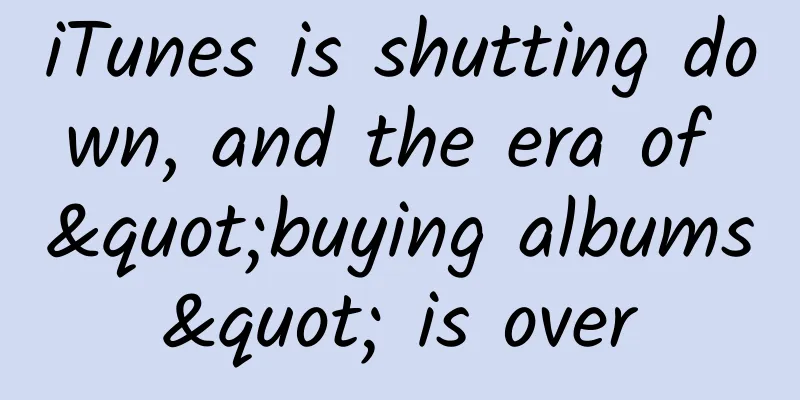iTunes is shutting down, and the era of "buying albums" is over

|
All signs indicate that Apple is preparing to shut down the iTunes service. When they woke up, many netizens discovered that Apple had deleted all of iTunes's content on Facebook, and all the videos and pictures in iTunes' Instagram profile were cleared without any prior warning. Apple is said to have transferred the content of the iTunes Facebook page to the Apple TV page on Facebook, including content since the account was created on April 29, 2009. Clearing social media indicates that iTunes may be undergoing major changes. According to Bloomberg, Apple will announce the closure of iTunes service at the WWDC 2019 conference which will open on June 3rd, Pacific Time. At the same time as iTunes is retired, Apple will launch three new software for macOS, providing management services for music, TV movies and audio, which have been launched on iOS in the past. The three new software are actually equivalent to splitting the major functions of iTunes into different applications, and basic functions such as synchronization and restoration between iTunes and iPhone may be undertaken by the newly launched music application.
The predecessor of iTunes was actually a music management software called SoundJam MP. After Apple bought the copyright of the software, Jobs and others cut off many responsible functions and improved the user interface on the original basis. They changed the original search by singer, song name or album name to a simple search box and named the software iTunes. In January 2001, Jobs officially released iTunes at the Macworld Conference. That fall, Apple released another music player, iPod, which was compatible with iTunes, which set off a new revolution in the music market. In 2003, Apple launched the iTunes Store, selling songs to users at 99 cents per song. In six days, 1 million songs were sold. Jobs said, "This will go down in history as a turning point in the music industry." For Apple users at the time, importing music downloaded from the Internet to iPod was necessary through iTunes. This hardware and software integration strategy made iPod and iTunes the largest source of revenue for Apple. The iTunes Store sold 70 million songs in its first year, and the iPod once occupied more than 70% of the music player market. By 2007, iPod sales accounted for half of Apple's total revenue. The digital music subscription model provided by the iTunes Store replaced traditional music distributors in establishing direct contact with users and sharing profits with music copyright holders. It was actually the predecessor of Apple's App Store. However, as a software born in the PC Internet era, iTunes has gradually been marginalized along with the iPod with the advent of mobile Internet. Since then, the iPhone and App Store have ushered in a golden decade. Although Apple continues to update iTunes and integrates multiple features such as music, movies, TV shows, podcasts, iTunes U, applications, audiobooks, etc. into iTunes, more often iTunes is just used as a less commonly used backup and download tool. Last year, revenue from iTunes music download business dropped to half of that in 2014. On the other hand, the number of Apple Music users is growing rapidly, and the number of paying users in the United States has surpassed that of another music streaming giant, Spotify. In addition, according to the Wall Street Journal, the market share of iTunes movie rentals and sales has been declining in recent years. It was over 50% in 2012, but only 20%-35% in 2017. As streaming subscription services such as Netflix become mainstream, this number is estimated to continue to decline. In March this year, Apple held a hardware-free press conference and instead focused on software services such as video, news, games and mobile payments. Services will become a more important part of Apple's future.
Apple's service revenue reached $11.45 billion in the last fiscal quarter, a record high. Currently, the number of paying users using Apple services and third-party businesses has reached 390 million, and Apple hopes to increase this number to 500 million in 2020. Although iTunes is the pioneer of Apple's digital service subscription model, it is no longer suitable for the streaming era. Users have no choice but to spend $9 to subscribe to all the movies and TV shows on Netflix or spend $20 to buy a movie on iTunes. However, the model of iTunes that aggregates multiple media services such as music, video, and blogs is too bloated and difficult to compete with vertical applications in the streaming media field such as Netflix and Spotify. Therefore, it is difficult for iTunes to have a place in Apple's future service business map. |
<<: Huawei Mate 20 Pro returns to the Android Q list
>>: 48 hours later at WWDC19, you will see new changes from Apple
Recommend
Microsoft patent: The next generation of Windows system is exposed, compatible with Android!
Microsoft's dual-screen device, code-named &q...
What will happen to the new energy vehicle market if the huge subsidies disappear?
Last year, one out of every two electric cars sol...
Common traffic interception tactics for Internet marketing and promotion!
01Good content is the essence of traffic generati...
Electric Technology Auto News: Harvard's new H8 will be launched. Can the 8-speed gearbox change the bad luck of poor sales?
Starting with the H6, Haval established its posit...
Annual output reaches 2 billion cubic meters! This 100 billion cubic meter gas field in the Sichuan Basin heads southwest
According to the Sinopec News Office, another 100...
Microsoft Edge 93 for Android released
[[422344]] Following the desktop update, Microsof...
The Earth is getting hotter and hotter. How long can humans survive? The key is up to us.
If nothing is changed, a devastating disaster wil...
How to activate the 400 customer service phone number? What are the application procedures for the 400 phone number?
How to activate the 400 customer service phone nu...
Chrome update for iOS: Can replace Safari as the default web browser
In iOS 14, if users don’t like native Safari and ...
How should operations use data?
How should operations use data? This question ste...
3 strategies for APP overseas promotion!
Entering 2019, overseas traffic costs are still o...
Hot on the Internet! What is this plant that can produce "gems"?
Recently, a plant called "Opal Berry" h...
Fengjie teaches you how to write 10w+ stories
Fengjie’s article became popular. The article &qu...
Why are Want Want’s marketing ads so magical?
I recently watched two Want Want commercials. The...
Animals imitate humans in fighting! Has your dog ever imitated you?
Review expert: Li Weiyang, a well-known popular s...









